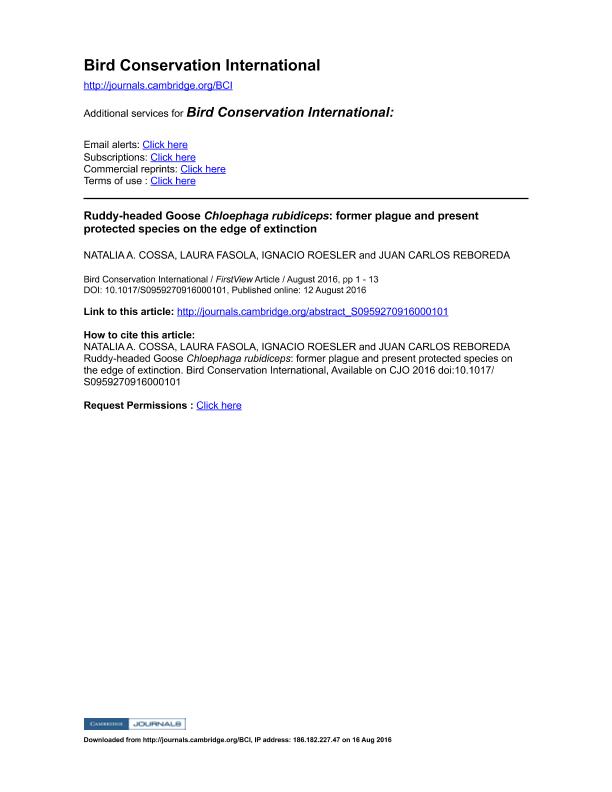Mostrar el registro sencillo del ítem
dc.contributor.author
Cossa, Natalia Andrea

dc.contributor.author
Fasola, Laura

dc.contributor.author
Roesler, Carlos Ignacio

dc.contributor.author
Reboreda, Juan Carlos

dc.date.available
2018-09-19T19:44:40Z
dc.date.issued
2017-06
dc.identifier.citation
Cossa, Natalia Andrea; Fasola, Laura; Roesler, Carlos Ignacio; Reboreda, Juan Carlos; Ruddy-headed Goose Chloephaga rubidiceps: Former plague and present protected species on the edge of extinction; Cambridge University Press; Bird Conservation International; 27; 2; 6-2017; 269-281
dc.identifier.issn
0959-2709
dc.identifier.uri
http://hdl.handle.net/11336/60338
dc.description.abstract
The Ruddy-headed Goose Chloephaga rubidiceps has two separate and genetically distinct populations, one sedentary that inhabits the Malvinas/Falklands Islands and another migratory, which inhabits continental southern South America. New information suggests that these populations should be considered as different evolutionarily significant units. The latter population breeds in Austral Patagonia (Argentina and Chile) and overwinters in Central Argentina. It was a very common species in Austral Magellanic steppe grasslands before 1931, when it was declared an agricultural pest by the Argentinian government, together with other sheldgeese species. Since then, the continental Ruddy-headed Goose population has declined becoming one of the scarcest species in Austral Magellanic steppe. Nowadays, its population is categorised as critically endangered in Argentina and endangered in Chile. We present data from six road censuses conducted in the breeding areas of Santa Cruz and Tierra del Fuego provinces, Argentina, during 2013-2014 and 2014-2015 (>4600 km, 70 days) and review population trends of the Ruddy-headed Goose since the early 1900s. We counted a maximum of 19 individuals in Santa Cruz and 49 in Tierra del Fuego throughout the breeding season. A literature review indicates that during the last 40 years the size of continental population of Ruddy-headed Goose has been < 800 individuals, approximately 10% of the estimated population in the 1900s. This decline matches the period following the application of control techniques and the introduction of exotic predator species in the breeding grounds of Tierra del Fuego. We review and discuss formerly proposed conservation actions that may have a positive and rapid effect on sheldgoose numbers recovery. We suggest that the continental population of Ruddy-headed Goose should on a precautionary basis be treated as a critically endangered population until genetic studies determine whether we are in the presence of a new 'Critically Endangered' species.
dc.format
application/pdf
dc.language.iso
eng
dc.publisher
Cambridge University Press

dc.rights
info:eu-repo/semantics/openAccess
dc.rights.uri
https://creativecommons.org/licenses/by-nc-sa/2.5/ar/
dc.subject
Chloephaga Rubidiceps
dc.subject
Conservation
dc.subject
Austral Patagonia
dc.subject
Invasive Predators
dc.subject.classification
Otras Ciencias Biológicas

dc.subject.classification
Ciencias Biológicas

dc.subject.classification
CIENCIAS NATURALES Y EXACTAS

dc.title
Ruddy-headed Goose Chloephaga rubidiceps: Former plague and present protected species on the edge of extinction
dc.type
info:eu-repo/semantics/article
dc.type
info:ar-repo/semantics/artículo
dc.type
info:eu-repo/semantics/publishedVersion
dc.date.updated
2018-09-19T16:36:22Z
dc.journal.volume
27
dc.journal.number
2
dc.journal.pagination
269-281
dc.journal.pais
Reino Unido

dc.journal.ciudad
Cambridge
dc.description.fil
Fil: Cossa, Natalia Andrea. Consejo Nacional de Investigaciones Científicas y Técnicas. Oficina de Coordinación Administrativa Ciudad Universitaria. Instituto de Ecología, Genética y Evolución de Buenos Aires. Universidad de Buenos Aires. Facultad de Ciencias Exactas y Naturales. Instituto de Ecología, Genética y Evolución de Buenos Aires; Argentina
dc.description.fil
Fil: Fasola, Laura. Consejo Nacional de Investigaciones Científicas y Técnicas. Centro Austral de Investigaciones Científicas; Argentina
dc.description.fil
Fil: Roesler, Carlos Ignacio. Consejo Nacional de Investigaciones Científicas y Técnicas. Oficina de Coordinación Administrativa Ciudad Universitaria. Instituto de Ecología, Genética y Evolución de Buenos Aires. Universidad de Buenos Aires. Facultad de Ciencias Exactas y Naturales. Instituto de Ecología, Genética y Evolución de Buenos Aires; Argentina
dc.description.fil
Fil: Reboreda, Juan Carlos. Consejo Nacional de Investigaciones Científicas y Técnicas. Oficina de Coordinación Administrativa Ciudad Universitaria. Instituto de Ecología, Genética y Evolución de Buenos Aires. Universidad de Buenos Aires. Facultad de Ciencias Exactas y Naturales. Instituto de Ecología, Genética y Evolución de Buenos Aires; Argentina
dc.journal.title
Bird Conservation International

dc.relation.alternativeid
info:eu-repo/semantics/altIdentifier/doi/http://dx.doi.org/10.1017/S0959270916000101
dc.relation.alternativeid
info:eu-repo/semantics/altIdentifier/url/https://www.cambridge.org/core/journals/bird-conservation-international/article/ruddyheaded-goose-chloephaga-rubidiceps-former-plague-and-present-protected-species-on-the-edge-of-extinction/0F5EFF6F7B7409DF6FAADA86B5E07142
Archivos asociados
